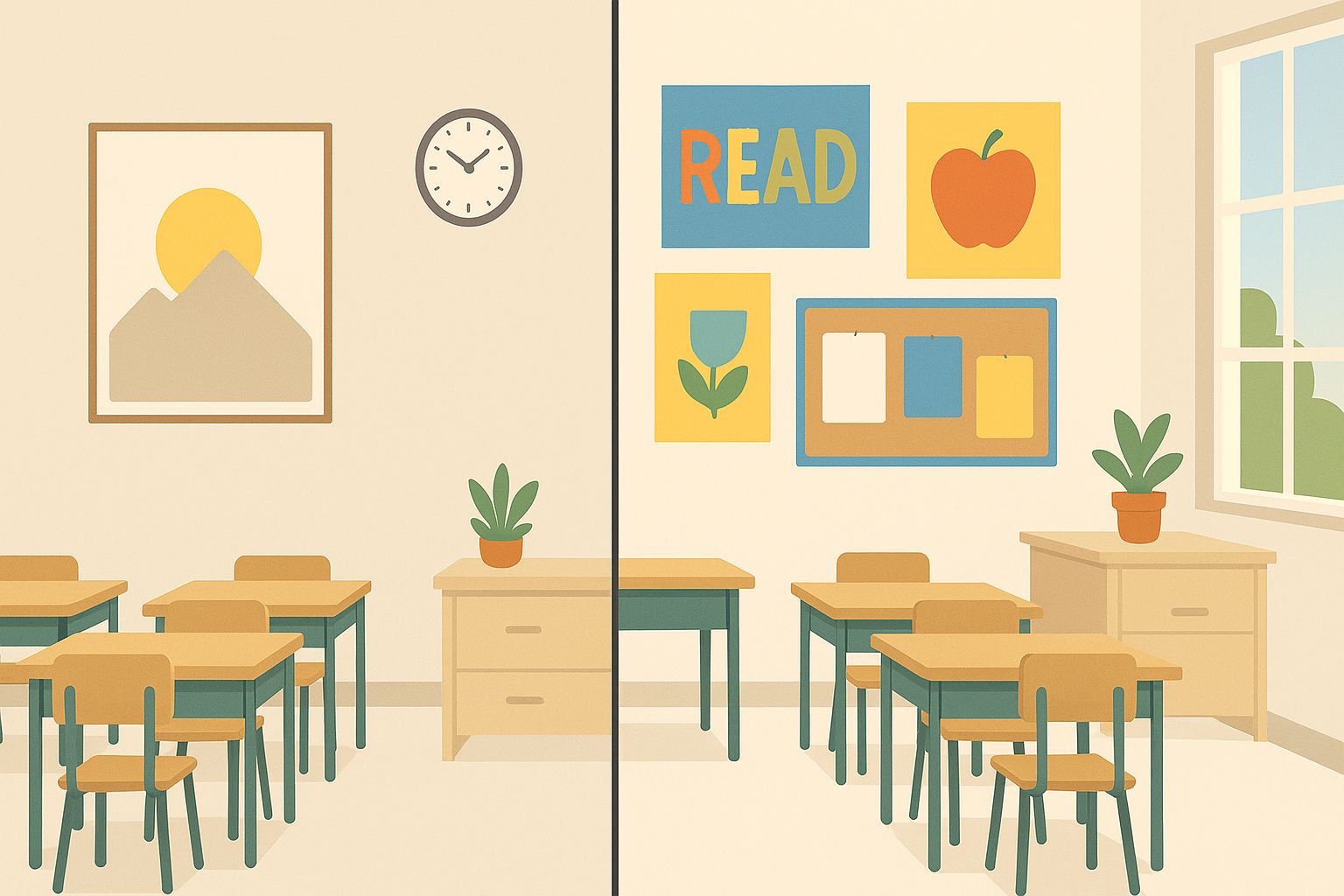- The PEN Weekly
- Posts
- PEN Mondays - The Pinterest Classroom
PEN Mondays - The Pinterest Classroom
When Classroom Decoration Becomes a Competition

MAKING IT EASIER TO BE A BETTER TEACHER
6 min read
If you’re new here, welcome to PEN Mondays, where we explore more of the socio-emotional aspects of teaching. You’ll see us again on Wednesday with a brand new tech tool and academic study to supercharge your classroom.
The Rise of the Pinterest Classroom
You walk into a classroom and for a second, you wonder if you accidentally wandered into a home décor photoshoot. The bulletin boards match the color scheme of the chairs. The storage bins are perfectly labeled in the same font. There are fairy lights framing the whiteboard, plants in every corner, and a “Welcome” banner that looks like it came straight from an Etsy shop.
It’s a far cry from the classrooms of the past — you know, the ones with a world map, a couple of motivational posters, a battered class library, and maybe a hanging plant if someone remembered to water it.
So what happened? In short: social media. Pinterest boards, Instagram reels, and “Classroom Makeover” TikToks have fueled a new era of design-savvy classrooms. And while there’s nothing inherently wrong with that, it’s created a new pressure point in teaching — one that has nothing to do with lesson plans or student learning.
NOTEWORTHY NEWS
Here’s our weekly roundup of interesting education stories from around the world. Click each link to dive deeper:
A quick word from our sponsors:
AI You’ll Actually Understand
Cut through the noise. The AI Report makes AI clear, practical, and useful—without needing a technical background.
Join 400,000+ professionals mastering AI in minutes a day.
Stay informed. Stay ahead.
No fluff—just results.
Why Classroom Décor Matters

Before we all start rolling our eyes at twinkle lights and thematic bulletin boards, let’s acknowledge something important: décor does matter.
A thoughtfully decorated classroom can feel like an extension of a teacher’s personality. It can spark curiosity, help students feel comfortable, and set the tone for the kind of community you’re trying to build. Walking into a warm, inviting space can make a child feel welcome before you’ve even said a word.
For some teachers, decorating is also a creative outlet — a little pocket of joy in a profession where burnout is all too common. They aren’t trying to compete; they’re just making their space a reflection of who they are. And that can be a beautiful thing.
Student artwork, themed reading corners, cozy lighting, seasonal touches — these elements don’t just decorate; they help shape the emotional climate of the room.
Where It Can Go Too Far
But here’s where things get tricky: when décor becomes a measuring stick for teacher quality.
Parents walk through during open house and compare. Colleagues start to feel pressure. Administrators — consciously or not — may notice and draw conclusions. The classroom that looks like it belongs in a magazine is assumed to be “better” than the one with bare walls, even if the second teacher is a master at lesson planning and student engagement.
Then there’s the money. And the time. Not every teacher has the budget for Target hauls or the hours to stay late hot-gluing borders to bulletin boards. When the bar is set by what’s Instagrammable, it can leave some teachers feeling like they’re falling short in ways that have nothing to do with actual teaching.
And let’s be clear — research doesn’t show that more décor equals better outcomes. A cohesive color scheme won’t raise reading scores. A handcrafted seating chart won’t solve behavior issues.
Finding the Middle Ground

So, where’s the balance?
Think intentionality. If you love decorating, decorate! But choose pieces that make your space work better for you and your students. A cozy reading corner. A bulletin board where students rotate their own work. A few touches that feel personal without consuming your evenings and paycheck.
If you’d rather keep it simple, that’s fine too — a clean, uncluttered classroom can be just as inviting. Minimal décor can help reduce distractions, save time, and let your teaching do the talking.
And maybe as a profession, we can agree on this: let’s appreciate each other’s spaces without making them a competition. Celebrate the creative classrooms. Celebrate the minimalist ones. They all have value.
Final Bell: What Really Counts
At the end of the day, the most important element in any classroom isn’t the bulletin board, the seating arrangement, or the matching bins. It’s you.
Your teaching, your presence, and your connection with your students will always matter more than whether your walls are Pinterest-perfect. Some classrooms are vibrant and colorful; others are calm and sparse. Both can be places where students feel safe, inspired, and ready to learn.
So if your bulletin board is a masterpiece — wonderful. If it’s just holding up the fire drill schedule — that’s fine too. You’re still shaping lives every single day. And that’s the real art form.
WHAT DO YOU THINK?
We would LOVE to hear from you!
Reply to this email, or send us a message on Instagram! We’re here to walk with you in these crazy times!
Part of what makes The PEN Weekly community so special is the fact that our readers are teachers from around the world! We’re not going to lie, we think that’s pretty darn cool!
Do you know someone who would appreciate reading the PEN? Share this newsletter with them! Our goal is to reach as many teachers as possible, and to build a community of teachers supporting teachers.

Reply